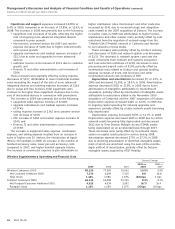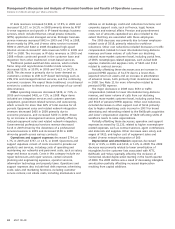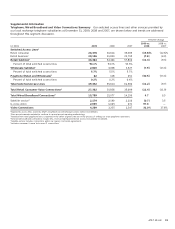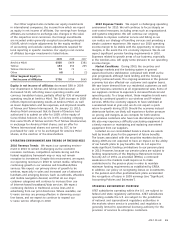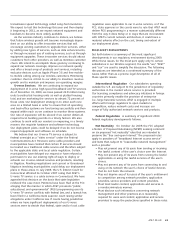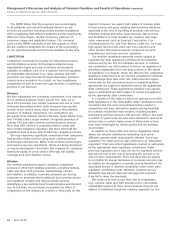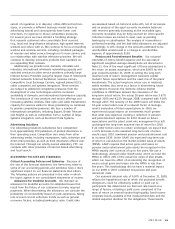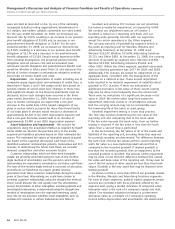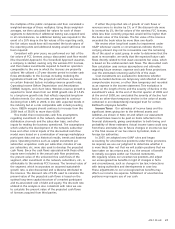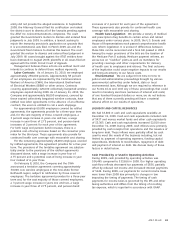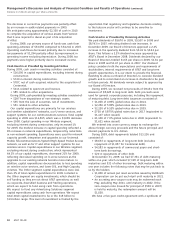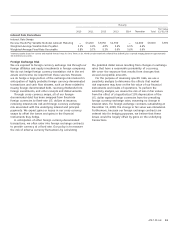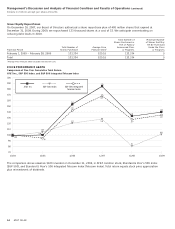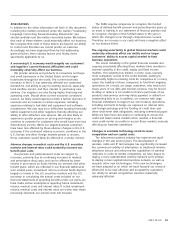AT&T Wireless 2009 Annual Report Download - page 47
Download and view the complete annual report
Please find page 47 of the 2009 AT&T Wireless annual report below. You can navigate through the pages in the report by either clicking on the pages listed below, or by using the keyword search tool below to find specific information within the annual report.
AT&T 09 AR 45
are assessed based on historical write-offs, net of recoveries,
and an analysis of the aged accounts receivable balances
with reserves generally increasing as the receivable ages.
Accounts receivable may be fully reserved for when specific
collection issues are known to exist, such as pending
bankruptcy or catastrophes. The analysis of receivables is
performed monthly, and the bad-debt allowances are adjusted
accord ingly. A 10% change in the amounts estimated to be
uncollectible would result in a change in uncollectible
expense of approximately $120.
Pension and Postretirement Benefits Our actuarial
estimates of retiree benefit expense and the associated
significant weighted-average assumptions are discussed in
Note 11. One of the most significant of these assumptions is
the return on assets assumption, which was 8.50% for the
year ended December 31, 2009. In setting the long-term
assumed rate of return, management considers capital
markets’ future expectations and the asset mix of the plans’
investments. The actual long-term return can, in relatively
stable markets, also serve as a factor in determining future
expectations. However, the dramatic adverse market
conditions in 2008 have skewed the calculation of the
long-term actual return; the actual 10-year return was 3.67%
through 2009 and 4.21% through 2008, compared with 9.18%
through 2007. The severity of the 2008 losses will make the
10-year actual return less of a relevant factor in manage-
ment’s evaluation of future expectations. In 2009, we
experienced actual returns on investments much greater
than what was expected, creating a reduction in pension
and postretirement expense for 2010. Based on future
expectations and the plans’ asset mix, management has left
unchanged the long-term assumed rate of return for 2010.
If all other factors were to remain unchanged, we expect that
a 1.0% decrease in the assumed long-term rate of return
would cause 2010 combined pension and postretirement cost
to increase $639. Under GAAP, the expected long-term rate
of return is calculated on the market-related value of assets
(MRVA). GAAP requires that actual gains and losses on
pension and postretirement plan assets be recognized in the
MRVA equally over a period of up to five years. We use a
methodology, allowed under GAAP, under which we hold the
MRVA to within 20% of the actual fair value of plan assets,
which can have the effect of accelerating the recognition of
excess actual gains and losses into the MRVA in less than
five years. This methodology did not have a material impact
on our 2008 or 2007 combined net pension and post-
retirement costs.
Our assumed discount rate of 6.50% at December 31, 2009,
reflects the hypothetical rate at which the projected benefit
obligations could be effectively settled or paid out to
participants. We determined our discount rate based on a
range of factors, including a yield curve comprised of the
rates of return on several hundred high-quality, fixed-income
corporate bonds available at the measurement date and the
related expected duration for the obligations. These bonds
extent of regulation is in dispute), utilize different tech nol-
ogies, or promote a different business model (such as
advertising based) and consequently have lower cost
structures. In response to these competitive pressures,
for several years we have utilized a bundling strategy
that rewards customers who consolidate their services
(e.g., local and long-distance telephone, high-speed Internet,
wireless and video) with us. We continue to focus on bundling
wireline and wireless services, including combined packages
of minutes and video service through our U-verse service and
our relationships with satellite television providers. We will
continue to develop innovative products that capitalize on
our expanding fiber network.
Additionally, we provide local, domestic intrastate and
interstate, international wholesale networking capacity and
switched services to other service providers, primarily large
Internet Service Providers using the largest class of nationwide
Internet networks (Internet backbone), wireless carriers,
Competitive Local Exchange Carriers, regional phone ILECs,
cable companies and systems integrators. These services
are subject to additional competitive pressures from the
development of new technologies and the increased
availability of domestic and international transmission capacity.
The introduction of new products and service offerings and
increasing satellite, wireless, fiber-optic and cable transmission
capacity for services similar to those provided by us continues
to provide competitive pressures. We face a number of
international competitors, including Equant, British Telecom
and SingTel as well as competition from a number of large
systems integrators, such as Electronic Data Systems.
Advertising Solutions
Our Advertising Solutions subsidiaries face competition
from approximately 100 publishers of printed directories in
their operating areas. Competition also exists from other
advertising media, including newspapers, radio, television and
direct-mail providers, as well as from directories offered over
the Internet. Through our wholly-owned subsidiary, YPC, we
compete with other providers of Internet-based advertising
and local search.
ACCOUNTING POLICIES AND STANDARDS
Critical Accounting Policies and Estimates Because of
the size of the financial statement line items they relate to,
some of our accounting policies and estimates have a more
significant impact on our financial statements than others.
The following policies are presented in the order in which
the topics appear in our consolidated statements of income.
Allowance for Doubtful Accounts We maintain an
allowance for doubtful accounts for estimated losses that
result from the failure of our customers to make required
payments. When determining the allowance, we consider the
probability of recoverability based on past experience, taking
into account current collection trends as well as general
economic factors, including bankruptcy rates. Credit risks



